Alice the Sheep: A Story of Biodiversity, Wisdom, and Weeds
Alice Jnr - descendant of Alice the original face of White Gum Wool
Meeting Alice Jnr
Last year In my TEDx talk I introduced everyone to Alice Jnr a sheep from the Farm where I buy all my wool from. Nan Bray, the inspiring force behind White Gum Wool, is quick to confess that much of her shepherding wisdom came from Alice Jnr’s mother ‘Alice’ and the “weeds” that flourish across her property.
The Master Sheepwalker and a Keen Nose
Alice wasn’t just any ewe. Years back in the midst of a brutal drought, Nan found Alice after a difficult lambing, unable to walk and destined for a rough end. Driven by that innate stock sense, Nan didn’t give up, she lugged Alice to the shed and made it her mission to help her recover. Each morning, Alice got strapped into a contraption called the “Master Sheepwalker” and wheeled out to nibble whatever green stuff she could reach.
What Sheep Really Eat
But it was here, out in the paddock, that Nan first noticed something truly eye-opening. Alice didn’t eat at random. With her nose to the ground, she systematically chose her way through six different types of introduced plants (yes, what most would call weeds) before settling for grass. Each time, Alice ate her preferred species first, picked them down to the stubble, then went on to the next best. If she ran out, she’d give Nan a look as if to say, “Time to move me along.”
Smell, Instinct, and Sheep Wisdom
This wasn’t just quirky sheep behaviour, it was a window into something much bigger. Nan realised sheep can’t actually see right under their noses; as prey animals, their eyes are set to scan the horizon. So, Alice was using her sense of smell, picking out what her body craved most at every meal. This simple insight sparked a revolution in how Nan viewed her entire farm.
A New Way of Farming
A bit of scientific digging supported what Alice had been showing every day: mammals, including sheep, need access to a broad array of plant species, not just grass, but every odd weed and herb under the sun. These plants offer all kinds of nutrients and natural compounds, helping animals balance their diet and maintain robust health.
Healthier Flocks, Healthier Land
Armed with this knowledge, Nan flipped her farming approach on its head: fewer sheep, more biodiversity, and, most importantly, she stopped separating mothers and lambs. The flock now learns foraging wisdom from the older generation, passing down what to eat and where to find it, just as Alice taught herself (and Nan).
Alice’s Legacy
Nan’s animals became healthier, happier, and much less prone to pesky problems like intestinal worms. The paddocks flourished, with weeds and native grasses popping back in abundance, supporting not only sheep but also a thriving ecosystem of birds, wallabies, and even rare native orchids. Alongside her her daughter Alice Jnr (pictured above), Alice’s legacy lives on in a whole different approach to shepherding and farming as well as the flourishing wonder that is White Gum Wool. You can watch a short excerpt from my TEDx talk below which talks more about this incredible wool and the approach which underpins it.
The Bigger Picture
Alice, for her part, lived a full, long life and even became the face on the White Gum Wool ball bands. Her story isn’t just about one sheep’s recovery, it’s a reminder that so-called weeds and wayward ewes can transform a landscape and a livelihood. The lesson is clear: when you work with nature, and not against her, you might find your best teachers have four legs and more wisdom than you’d ever guessed.
Every Piece of Clothing Has a Story
TEDx Hobart 2024

